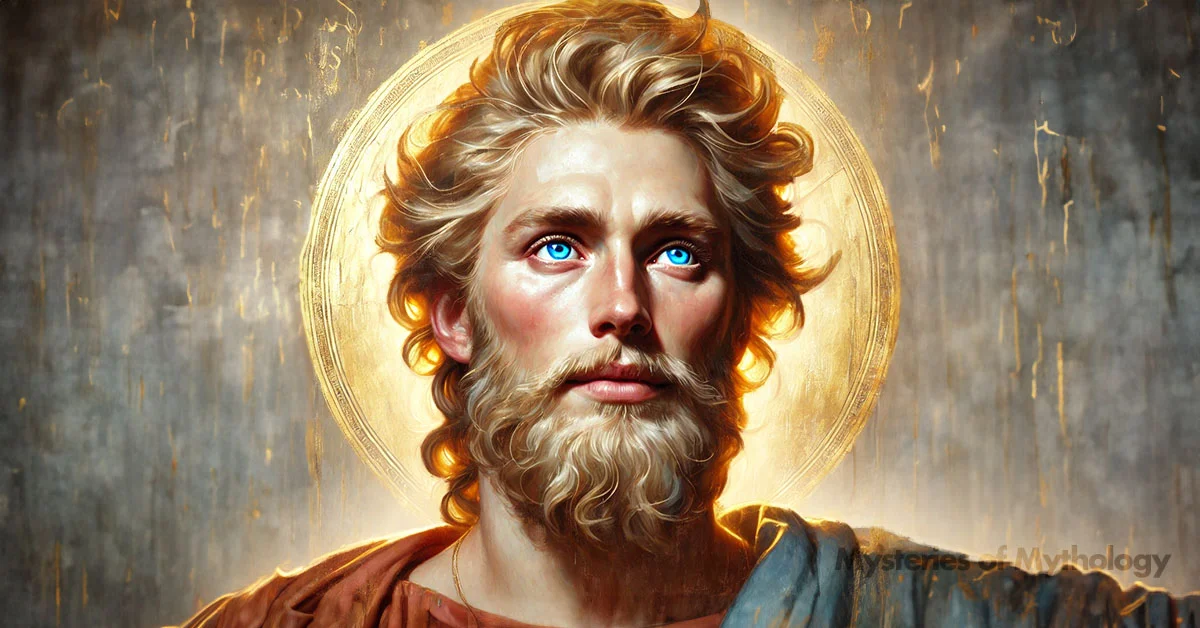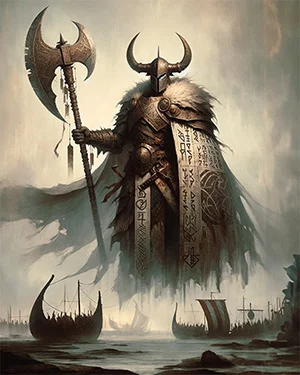Overview
In Norse mythology, Baldur was a radiant and cherished god of the Aesir tribe. He was known for his extraordinary beauty, wisdom, and charm and was said to emit light from his very being. Baldur was essential as a peacemaker, resolving conflicts among gods and mortals with his fair judgment.
The story of Baldur’s tragic death is a cornerstone of Norse legends. Despite his mother’s efforts to protect him, Baldur was killed through the cunning schemes of Loki, the trickster god. Nearly all beings mourned his loss, except for one… Loki.
Baldur’s death was a critical turning point in Norse mythology. It led to Loki’s punishment and confinement that set the stage for Ragnarök, the prophesied end of the world. His story is filled with themes of fate, betrayal, and the fragility of even the gods.
Want to know more? Read on…
Watch the related video
Etymology
Baldur’s name has been a topic of debate for some time. For a while historians thought the name “Baldur” originated from the Old Norse word “baldr,” which meant “bold” or “brave.” However, some scholars suggest that this interpretation might be backwards – the word “baldr” may have actually been derived from the god’s name, rather than the other way around.
Modern language studies propose a different origin for Baldur’s name. It’s thought that it may stem from the proto-Indo-European root “bhel-,” which means “white.” This connection to whiteness is significant in Norse mythology, as words denoting “white” were frequently used to describe Baldur and other Norse gods.
Importantly, when applied to deities, these words for “white” carried deeper meanings, more than just a colour. They were often translated as “bright” or “shining,” encompassing a range of divine qualities. These included brilliance, beauty, and clarity – all attributes that were strongly associated with Baldur in Norse myths.
Pronunciation
ENGLISH
Baldur
Old Norse
Baldr
PHONETIC
BAL-dur
IPA
/ˈbɑːldʊr/
Attributes
Baldur was known for his fairness, beauty, and likeable nature, which set him apart among the gods and made him admired and deeply beloved by both gods and mortals.
One of Baldur’s most notable possessions was his ship, Hringhorni, which means “ship with a circle on its stem,” hinting at its unique design. Hringhorni was celebrated as the greatest ship ever built, showing Baldur’s association with magnificence and craftsmanship. In a poignant turn of events, this grand vessel became Baldur’s funeral pyre after his death, set adrift in a river in a final journey befitting the god’s stature.
Baldur rode a great horse, Léttfeti. The horse’s fate was linked with its master’s, as it was sacrificed on Baldur’s funeral pyre.
Baldur’s dwelling, Breidablik, meaning “broad-gleaming,” reflected his radiant nature. This palace was described in the Grímnismál, a poem from the Poetic Edda, as the most peaceful of all places. In this collection of Norse poetry, Odin, disguised (which he often was), speaks of Breidablik as a land of unparalleled beauty and safety from evil.
“The seventh is Breithablik; Baldr has there For himself a dwelling set, In the land I know that lies so fair, And from evil fate is free.”
(“Grímnismál,” st. 12)
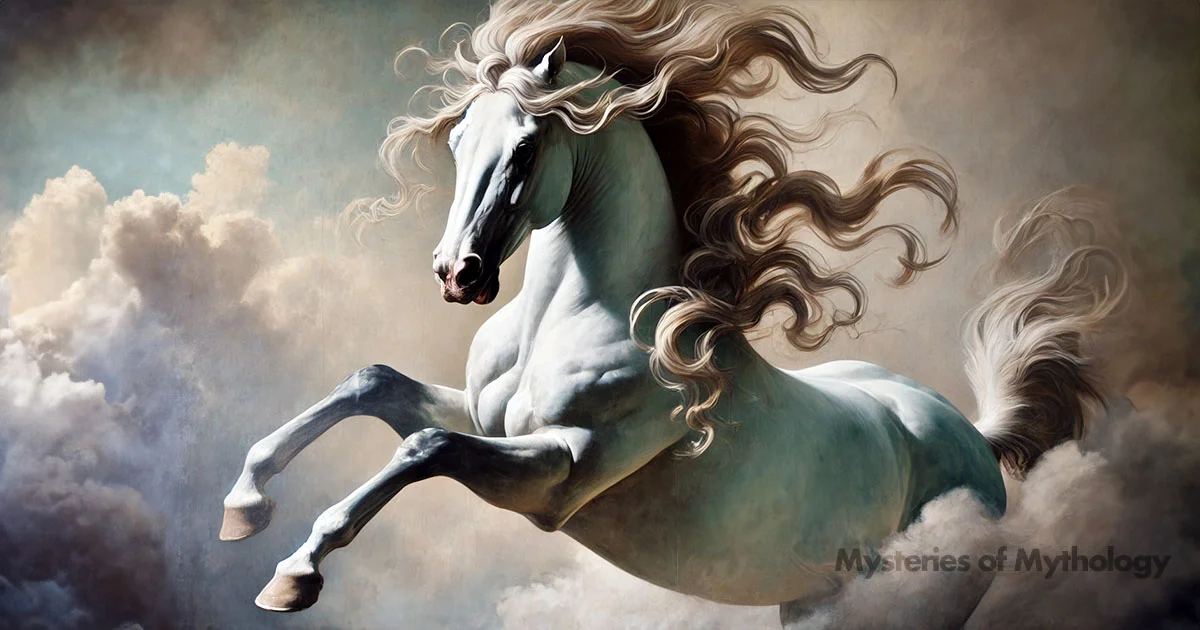
Family
Baldur’s father was Odin, the supreme deity of the Aesir tribe, and Frigg, the wise and prophetic goddess. His immediate family included his brother Hodr, and he also had several half-brothers from Odin’s many relationships, including Thor, Vidarr, Tyr, Heimdall, Hermod, and Bragi. After Baldur’s death, Odin fathered another son, Váli, with a giantess named Rindr to avenge Baldur’s death.
Baldur married Nanna, and they had a son named Forseti, who was known for peace and justice. Forseti established his own hall called Glitnir, continuing the family tradition of promoting harmony and deliberating justice, much like his father did.
Family Tree
Parents
Father
Odin
Mother
Frigg
Consorts
Wife
Nanna
Children
Son
Forseti
Mythology
The Death of Baldur and the Beginning of Ragnarök
Baldur is primarily mentioned in the story leading to his death and, ultimately, his rebirth in the new world, but it was one of the most popular stories in Norse mythology.
The story begins with foreboding dreams. Baldur, the beloved god of light and purity, experiences a nightmare foreseeing his own death. His mother, Frigg, known for her wisdom and foresight, shares the same dream. In Norse culture, such shared visions were considered potent omens, prompting immediate action from the gods.
Odin’s Quest for Knowledge
Determined to understand these visions, Odin sets off on a perilous journey. Riding Sleipnir, his eight-legged steed, Odin travels to Hel, a realm of the dead.
“Forward rode Othin, the earth resounded Till the house so high of Hel he reached.”
(“Baldrs Draumar,” st. 3.)
Disguising himself, as he often did, Odin arrived in the chilly, fog-shrouded realm of the dead. To his surprise, he found the halls decorated lavishly as if preparing for a grand celebration. Odin used his own magic to resurrect a völva, a practitioner of seidr magic. The völva wasn’t pleased to have her eternal rest disturbed. Despite her reluctance, Odin persisted in his questioning, asking who the festivities were for. The völva told him that they were preparing for Baldur’s arrival. Before she could recount the details of Baldur’s death, she saw through Odin’s disguise and refused to tell him any more.
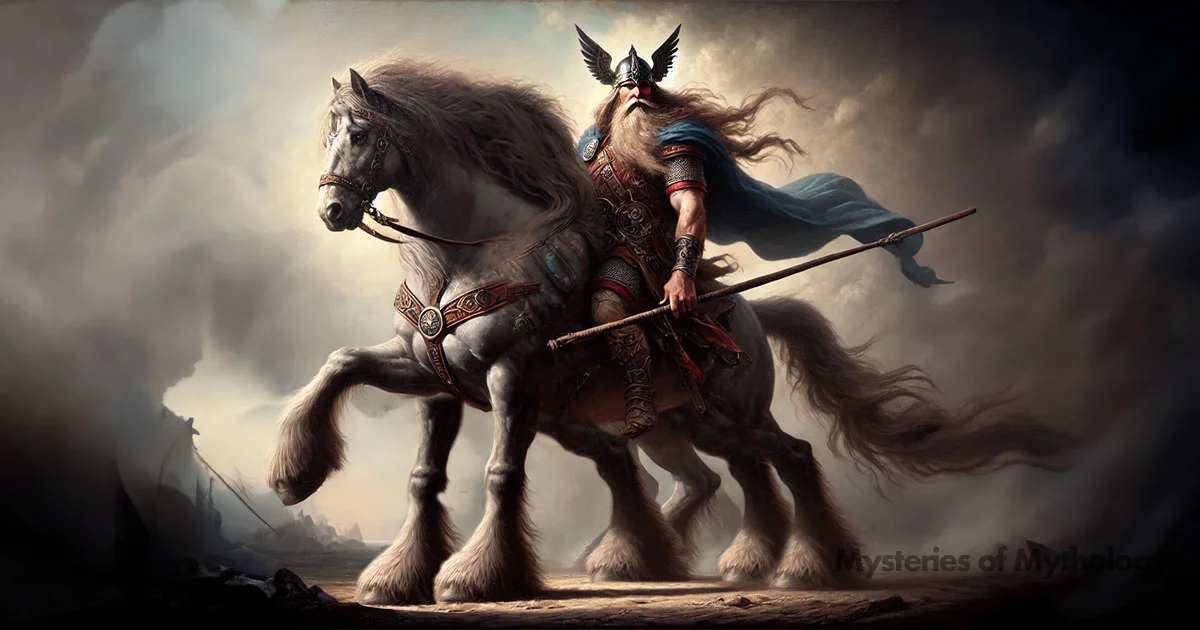
Frigg’s Desperate Measures
Odin returned to his kingdom, Asgard, sharing what he had heard from the seeress. Upon hearing the grim prophecy, Frigg takes drastic action. She approaches every entity in creation – living and inanimate – extracting solemn oaths that they will never harm Baldur.
“And Frigg took oaths to this purport, that fire and water should spare Baldr, likewise iron and metal of all kinds, stones, earth, trees, sicknesses, beasts, birds, venom, serpents.”
“And when that was done and made known, then it was a diversion of Baldr’s and the Æsir, that he should stand up … and all the others should some shoot at him, some hew at him, some beat him with stones, but whatsoever was done hurt him not at all, and that seemed to them all a very worshipful thing.”
(Sturluson, “Gylfaginning,” 71.)
Frigg had made Baldur almost invincible. The other gods made it a sport of throwing sticks, stones, and anything else they found that would simply bounce off him. Everyone, including Baldur, would laugh at this joyfully. But, of course, mischief will always find a way.
Loki’s Treachery
Loki, the notorious trickster god, took offence at Baldur’s newfound invulnerability. Disguising himself as a woman, he approached Frigg, asking if she had indeed received an oath from everything in the cosmos. Frigg shared that she overlooked the young and harmless mistletoe in her oath-taking, for it surely would be able to harm her son. Seizing this opportunity, Loki crafted a spear (or arrow, depending on the version) from mistletoe, setting the stage for tragedy.
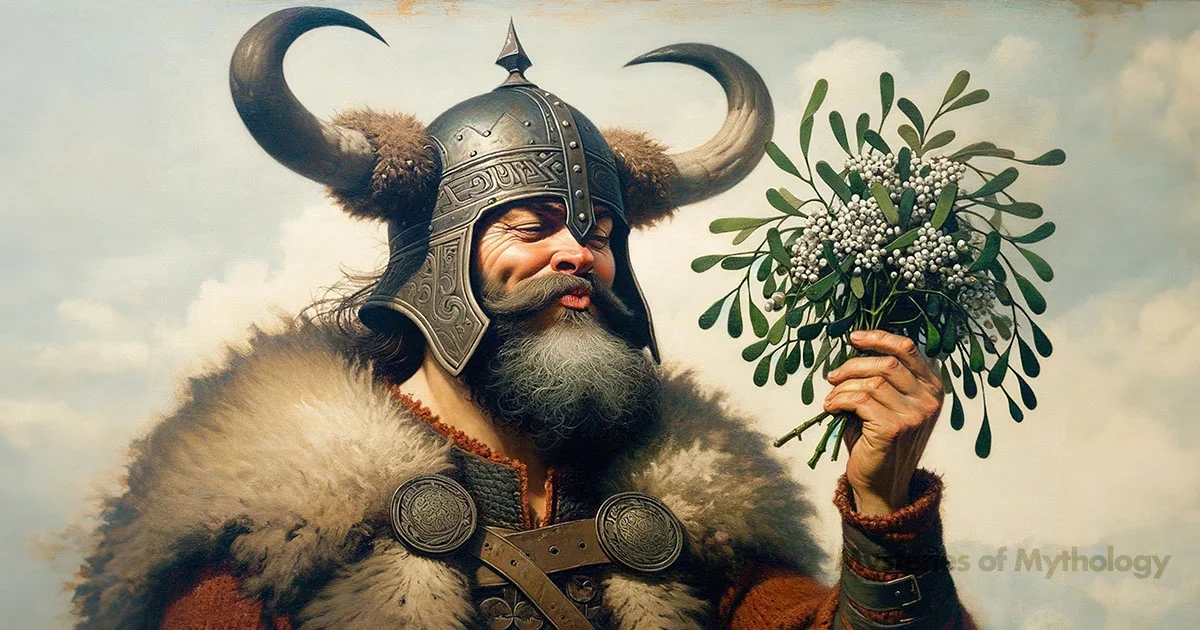
The Fatal Game
During one of the gods’ gatherings, where they would make sport of Baldur’s invulnerability, Loki approaches Hodr, Baldur’s blind brother. Hodr was often left out of such games, so when Loki offered to guide Hodr’s aim, he accepted. Loki handed him the mistletoe spear. Not knowing that the spear was made of the one thing that would harm his brother, Hodr threw the spear, striking Baldur and fatally wounding him. After Baldur fell, Odin whispered a mysterious message in his dying son’s ear, the content of which remains one of Norse mythology’s great mysteries.
The other gods found themselves trembling in shock and fear, not only at the death of the most loved god, but his death would herald the coming of Ragnarök.
The Quest to Retrieve Baldur
Grief-stricken but hopeful, Frigg called for a volunteer to journey to Hel and negotiate Baldur’s release. Hermod, another of Odin’s sons, stepped forward. Riding Sleipnir, Odin’s eight-legged steed, Hermod undertook an arduous nine-day journey to Hel’s realm.
Hel’s Condition
Upon arrival in Hel, Hermod found Baldur seated at Hel’s table, a poignant image of the beloved god’s new existence in the underworld. Baldur was seen in a state of grace and calm, contrasting the grim surroundings of Helheim. Like all the other gods, Hel, the goddess of death, was fond of Baldur, so she agreed to release him from the underworld, but only on one condition: that all things in creation wept for him.
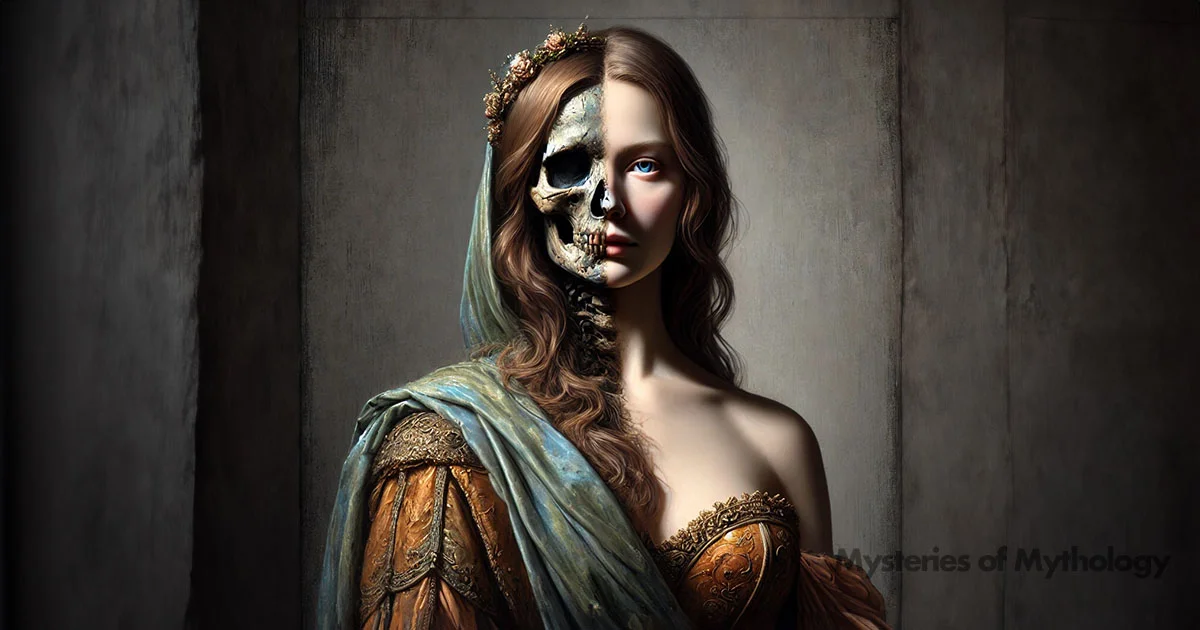
When Hermod returned and shared the news, the gods dispatched messengers far and wide, and indeed, nearly every entity shed tears for Baldur. It was said that even stones and trees wept for him, showing just how much he was loved in the cosmos. However, they encountered an old giantess named Thökk, who was actually Loki in disguise. Thökk refused to mourn, uttering the fateful words:
“Thökk will weep waterless tears For Baldr’s bale-fare;
Living or dead, I loved not the churl’s son; Let Hel hold to that she hath!”(Sturluson, “Gylfaginning,” 75.)
And so, Loki condemned Baldur to remain in the realm of the dead, marking a key moment in Norse mythology.
The Funeral of Baldur
Accepting Baldur’s fate, the gods arranged a lavish funeral for their fallen friend. They turned Baldur’s ship, Hringhorni, into a pyre fitting for a great king. When the time came to launch the ship out to sea, the gods found it stuck in the sand and could not move it. After many failed attempts, they summoned the brawniest being in the cosmos, a giantess named Hyrrokkin, whose name meant “Withered by Fire.” Hyrrokkin arrived in Asgard riding a wolf and using poisonous snakes for reins. She dismounted, walked to the ship’s prow, and gave it such a mighty push that the land quaked as Hringhorni was freed from the strand.
As Baldur’s body was carried onto the ship, his wife, Nanna, was overcome with such tremendous grief that she died there on the spot and was placed on the pyre alongside her husband. The fire was kindled, and Thor blessed the flames by holding his hammer over them. Odin laid upon the pyre his ring Draupnir, and Baldur’s horse was led into the flames, joining his master on the final journey.
Divine Vengeance
Seeking vengeance for his son’s death, Odin fathered another son named Váli with the giantess Rindr. Váli grew to adulthood in a single day and, fulfilling his purpose; slayed Hodr.
The gods then turned their wrath on Loki. Loki had run away and hidden at a mountain’s peak so that he could watch for pursuers from all directions.
During the day, he transformed into a salmon and hid behind a waterfall, and by night, he sat by a fire and weaved a net for fishing. When Loki saw the other gods approach, he threw his net and jumped into the river in the form of a salmon. But the other gods saw the net smouldering in the fire and knew Loki wasn’t fire.
After a long search, Thor finally caught his half-brother in his salmon form, who was trying to escape, but the god of thunder held him tight by his tail fins. This is why the salmon has a slender tail.
After capturing him, Loki was taken to a cave and bound by the entrails of his son, Nari. They placed a venomous serpent above him, its poison dripping onto Loki’s face, causing him immense agony. Loki’s wife, Sigyn stayed by his side, catching the venom in a bowl. However, whenever she left to empty the bowl, the venom would drip onto Loki, causing him to writhe in pain and resulting in earthquakes. Loki’s suffering was prophesied to continue until Ragnarök, the twilight of the gods.
Hope for the Future
Despite the tragic events in Norse mythology, there is a glimmer of hope in the Völuspá prophecy. It foretells that after Ragnarök, during the rebirth of the world, both Baldur and Hodr will be resurrected. This resurrection symbolizes the world’s renewal.
“Fields unsowed will bear ripened fruit. All ills grow better, and Baldr comes back; Hod and Baldr, the gods’ unsown fields, will bear ripened fruit.”
(“Völuspá,” st. 61–62.)
Pop Culture
Literature and Comics
Baldur’s tragic story has inspired numerous literary works. In Neil Gaiman’s “American Gods,” a character named Mr. Wednesday (a representation of Odin) references Baldur’s death. The comic book series “The Sandman,” also by Gaiman, features Baldur as a minor character, maintaining his association with beauty and light.
In Rick Riordan’s “Magnus Chase and the Gods of Asgard” series, Baldur appears as a character, with his myth playing a significant role in the plot. The series introduces younger readers to Norse mythology, including Baldur’s story, in a modern context.
Video Games
Baldur has become a notable figure in video game narratives:
1. “God of War” (2018): Baldur is the primary antagonist and is portrayed as an invulnerable, tattooed warrior. The game reimagines his myth, incorporating elements of his invulnerability and the role of mistletoe in his downfall.
2. “Assassin’s Creed Valhalla” (2020): While not directly appearing, Baldur’s myth is referenced and plays a part in some of the game’s quests, introducing players to Norse mythology.
3. “Smite”: This multiplayer online battle arena game features Baldur as a playable character, emphasising his role as a god of light and purity.
Film and Television
Baldur’s presence in visual media has been growing:
- “The Almighty Johnsons” (2011-2013): This New Zealand TV series features Baldur as one of the main characters, reincarnated as a modern-day New Zealander.
- Marvel Cinematic Universe: Balder was referenced in Season 2, Episode 3 of “Loki,” titled “1893,” which aired on Disney+ in 2023. During this episode, Loki (Tom Hiddleston) and Agent Mobius (Owen Wilson) travel to the 1893 Chicago World’s Fair. While there, they encounter a Norse pavilion featuring wooden statues of Thor, Odin, and Balder.
- “Vikings” TV series: Though not a central character, Baldur is mentioned in the show, contributing to its authentic portrayal of Norse culture and beliefs.
Music
Baldur’s story has inspired various musical works:
- The German power metal band Blind Guardian included a song titled “Valhalla” on their album “Follow the Blind,” which references Baldur’s myth.
- The Swedish melodic death metal band Amon Amarth, known for their Viking-themed lyrics, has referenced Baldur in several songs.
Modern Paganism and New Age Spirituality
In some modern pagan and New Age practices, Baldur is invoked as a symbol of light, purity, and rebirth. His story is often interpreted as an allegory for the cycle of seasons, with his death representing winter and his prophesied return symbolising spring.
Academic and Cultural Impact
Baldur’s myth continues to be a subject of academic study, particularly in the fields of comparative mythology and Norse studies. The story’s themes of fate, sacrifice, and cosmic balance resonate with modern audiences, leading to ongoing analysis and reinterpretation in various cultural contexts.
Frequently Asked Questions
Is Baldur Freya’s son?
No, Baldur is not Freya’s son. He is the son of Odin and Frigg.
Who is Odin’s favourite son?
Baldur is often considered Odin’s favourite son in Norse mythology.
What was Baldur to Thor?
Baldur was Thor’s brother, as they were both sons of Odin.
What is Baldur the god of?
In Norse mythology, Baldur is the god of light, purity, joy, and summer.
Who killed Baldur?
Baldur was killed by his blind brother Höðr, who Loki tricked into throwing a mistletoe spear at Baldur.
References
“Baldrs Draumar.” Poetic Edda. Translated by Henry Adams Bellows.
“Grímnismál.” Poetic Edda. Translated by Henry Adams Bellows.
Sturluson, Snorri. “Gylfaginning.” Prose Edda.
“Völuspá.” Poetic Edda. Translated by Henry Adams Bellows.
Turville-Petre, E.O.G. 1964. Myth and Religion of the North: The Religion of Ancient Scandinavia.
Simek, Rudolf. 1993. Dictionary of Northern Mythology. Translated by Angela Hall.

